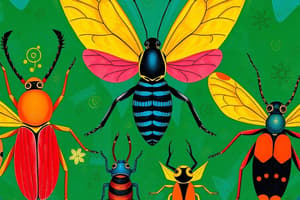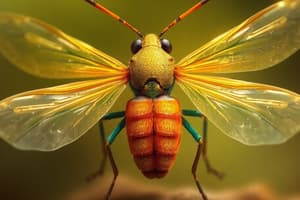Podcast
Questions and Answers
Match the insect order with their characteristic mouthpiece or method of obtaining food:
Match the insect order with their characteristic mouthpiece or method of obtaining food:
Coleoptera = Piercing/Sucking Lepidoptera = Chewing Hymenoptera = Siphoning Diptera = Chewing
Match the insect order with their characteristic wing shape:
Match the insect order with their characteristic wing shape:
Coleoptera = Thick wings that meet in a straight line down their back Lepidoptera = Four large, scaled wings Hymenoptera = Thin, translucent wings Diptera = Wings form a triangle on the back
Match the insect order with their approximate number of known species:
Match the insect order with their approximate number of known species:
Coleoptera = 150,000 Lepidoptera = 400,000 Hymenoptera = 130,000 Diptera = 120,000
Match the process of taxonomy with its description:
Match the process of taxonomy with its description:
Match the type of taxonomy with its description:
Match the type of taxonomy with its description:
Match the insect orders with their characteristics:
Match the insect orders with their characteristics:
Match the taxonomic ranks with their hierarchical order:
Match the taxonomic ranks with their hierarchical order:
Match the categories with their corresponding taxonomic groups:
Match the categories with their corresponding taxonomic groups:
Match the terms with their definitions in taxonomy:
Match the terms with their definitions in taxonomy:
Match the insect orders with their approximate number of species:
Match the insect orders with their approximate number of species:
Flashcards
Insect Classification
Insect Classification
Organizing insects into groups (orders) based on shared features like body shape, wings, and mouthparts.
Coleoptera
Coleoptera
The largest order of insects, containing beetles and weevils.
Lepidoptera
Lepidoptera
The second-largest order of insects, including butterflies and moths.
Taxonomy
Taxonomy
Signup and view all the flashcards
Linnaeus System
Linnaeus System
Signup and view all the flashcards
Animal Taxonomy
Animal Taxonomy
Signup and view all the flashcards
Insect Orders
Insect Orders
Signup and view all the flashcards
Vertebrates
Vertebrates
Signup and view all the flashcards
Invertebrates
Invertebrates
Signup and view all the flashcards
Study Notes
Insect Diversity
- There are approximately 400,000 known species of beetles (Order Coleoptera), which have thick wings that meet in a straight line down their back and use chewing to obtain food.
- Butterflies and moths (Order Lepidoptera) make up around 150,000 known species, with four large, scaled wings, and use siphoning to obtain food.
Taxonomy
- Taxonomy is the science of naming, describing, and classifying living organisms, including plants, based on behavioral, genetic, and biochemical variations.
- Classification is based on the characterization, identification, and classification of organisms into groups with similar characteristics, which are categorized into species.
- The Linnaeus classification system, with some modifications, is widely used to classify living beings.
Animal Taxonomy
- Animal taxonomy involves identifying, classifying, and naming animals, using the Linnaeus classification system.
- Animals are divided into two main categories: vertebrates (mammals, birds, reptiles, fish, and amphibians) and invertebrates (arthropods, mollusks, and annelids).
Linnaeus Classification System
- Linnaeus classified the universe into three broad kingdoms: animals, plants, and minerals, and divided kingdoms into classes, orders, genera, and species.
Entomology Taxonomy
- Taxonomists in entomology study organisms and identify them based on their characteristics, such as visible morphological characteristics or genetic differences.
- The Class Hexapoda (insects) is studied under a classification system with approximately 30 orders, many of which are of minor importance and are studied mainly for scientific interest.
Insect Orders
- Insects are classified into 30 groups called orders, based on the shape of their body, legs, mouthparts, and wings.
- The principles of classification of insects involve placing them into different taxonomical categories, including phylum, class, order, family, genus, and species.
Largest Insect Order
- The largest insect order is Coleoptera (beetles and weevils), representing about 40% of known insect species, with around 400,000 known species.
Second-Largest Insect Order
- The second-largest insect order is Lepidoptera (butterflies and moths), with approximately 150,000 known species.
Studying That Suits You
Use AI to generate personalized quizzes and flashcards to suit your learning preferences.




